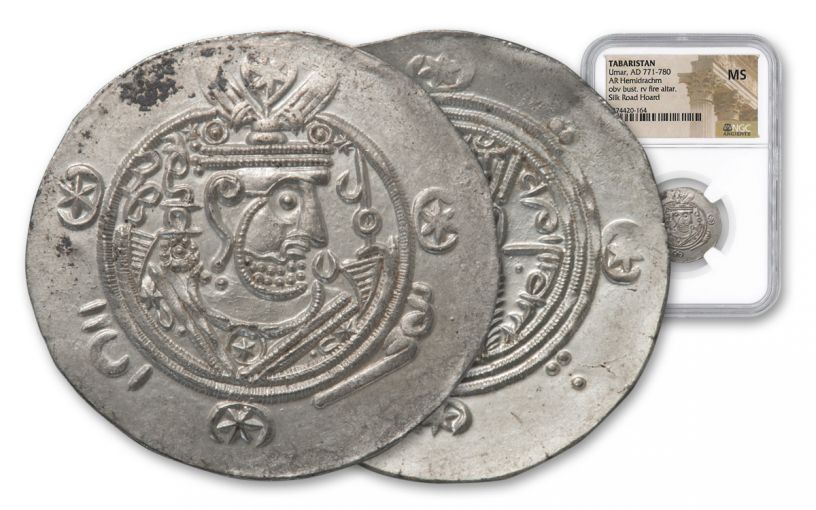Silver Hemidrachm of Umar
Coins of the Abbasid Governors of Tabaristan exist today in large numbers because they were used by merchants on the Silk Road, the ancient trade route that spanned more than 7,000 miles from Constantinople to China. The Kingdom of Tabaristan, located in modern-day northern Iran, was also located on the shore of the Caspian Sea, another major trade route.

Legacy of the Sasaniam Empire
After the Eastern Roman Empire fell into the Dark Ages, kingdoms like Tabaristan filled the void, facilitating the trade of goods, as well as culture and philosophy. In fact, for more than 400 years, the power of the Sasaniam Empire rivaled that of its neighboring arch-rival, the Roman-Byzantine Empire. The Sasaniam Empire was the last kingdom of the Persian Empire to fall to Islam, ruling from 224 to 651 AD. The influence of the Sasanian Empire also lasted long after it was conquered.
Tabaristan was one of the last parts of the Sasaniam Empire to fall to the Muslim Conquest. It resisted until 761 A.D. when it became a territory of the Abassid Caliphate. Even after it was conquered, Tabaristan remained largely independent of direct control of the Caliphate. The design of its coins also continued to reflect the Sassanian Empire.
Silver Hemidrachm of Umar
Tabistan was located on the northern branch of the Silk Road, serving as a vital link between the Far East and Constantinople. Its Silver Hemidrachm (1/2 drachm) was circulated up and down the Silk Road and became one of the most frequently used coins by merchants and traders.
One of the most common silver Hemidrachm was issued by Umar, Governor of Tabaristan. The coins were struck from 771-780 A.D. at the Tabaristan Mint and borrow much of their imagery from the coins of Sassanian King Khusru II.
The obverse features the bust of Umar ibn al-‘Ala, facing right and wearing winged crown. It is surmounted by a star and crescent, inside a single-dotted border. Crescents with stars are located at 3, 6 and 9 o’clock. The obverse includes inscriptions to the left (GDE ‘pzwty), to the right (‘wmr), and in the second quadrant of the margin (‘pd).
The reverse depicts Fire, the patron god of the Kingdom of Tabaristan, in a traditional fire altar. Two attendants stand facing the altar. They have crescents on their heads, with both hands on a sword hilt. The inscription to the left is “hptwystst,” while the inscription to the right is “tpwlst’n.”
